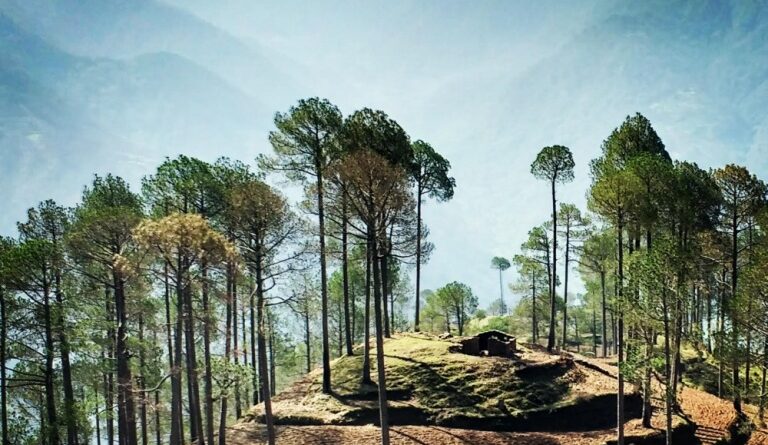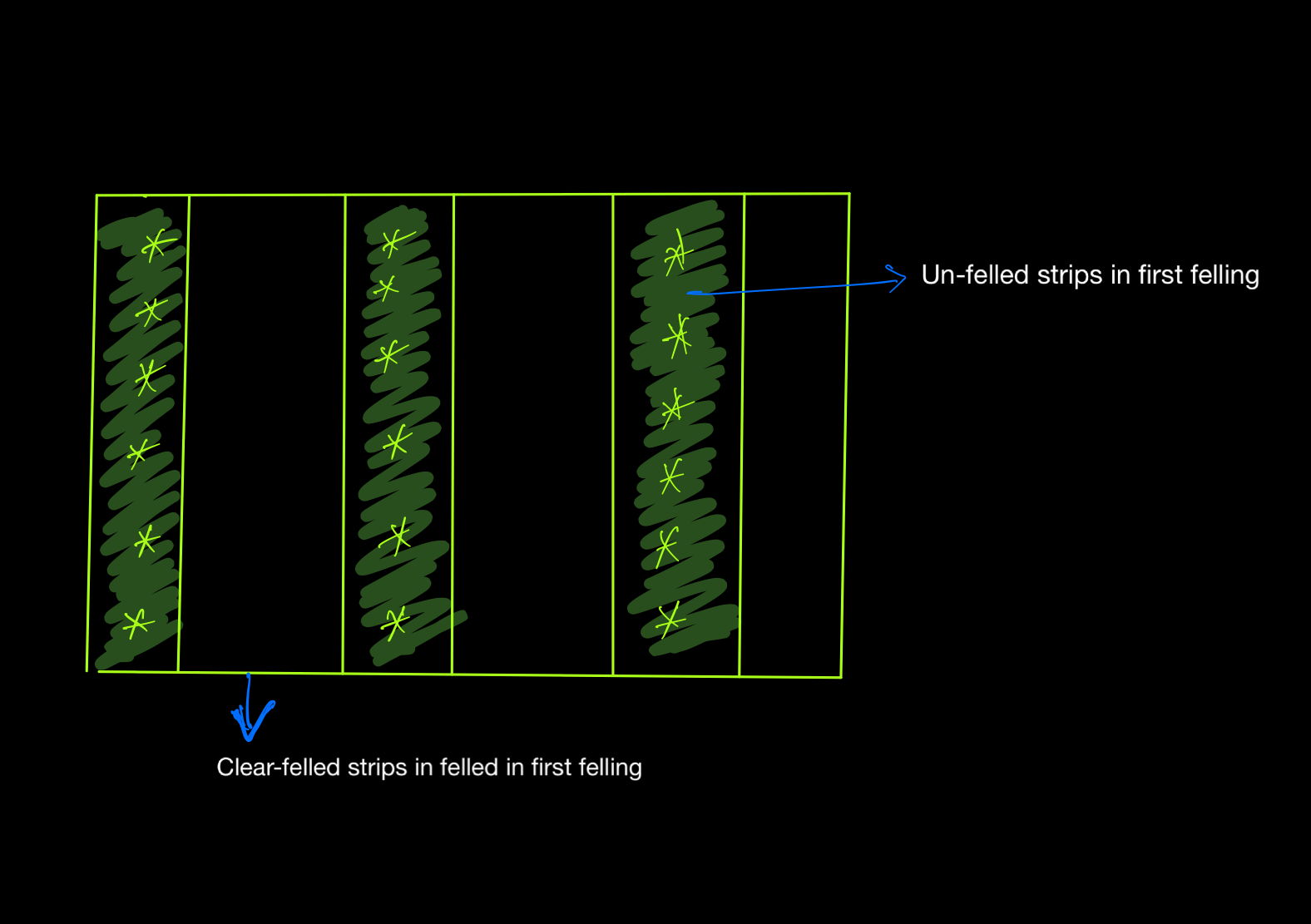Clear and Alternate Strip Felling Systems in SIlviculture
The Clear-strip System may be defined as a silvicultural system in which clear-felling is done in the form of strips which progress successively in one direction (usually against the prevailing direction of the wind) across the regeneration area. Since the strip fellings are made successively in one direction, it is also called as Progressive Clear-felling Strip System or shortly, as Progressive Strip System.
Pattern of Felling
Often it is not possible to clear-fell the whole of compartment or sub compartment in one operation. In such cases, clear-felling is done in the form of strips with the object of (i) regenerating the area naturally by seeds of adjoining area or (ii) protection of new crop against the wind, snow, insulations, etc.
In order to clear-fell strips in regular order, it is usually necessary to divide the regeneration area into as many cutting sections' as the number of years after which felling in the successive adjacent area can be done keeping the above mentioned two objects in view.
The clear-felled strip in this system are separated unfelled forest of sufficient width which may he a multiple of the width of clear-felled strip. The period after which unfelled forest adjacent to a clear-felled strip will he felled depends on (i ) completion of regeneration in the clear-felled strip, or (ii) the period for which protection against adverse factor is required. In cases in which natural regeneration from seeds of adjoining forest is to relied upon, it is necessary to leave a belt of trees unfelled in the last strip of the cutting section to supply the necessary seed. These trees can be removed when no longer required for the purpose.
[Cutting section - A sub-division of a felling series formed with the object of regulating felling in some special manner.]
Method of Regeneration
The clear-felled strip in this system may be regenerated artificially or naturally depending on circumstances. If natural regeneration can be obtained easily in a reasonably short period of time, it is resorted to: otherwise the strip is regenerated artificially. When natural regeneration from seed of unfelled trees is to be relied upon, it is necessary that felling should progress against the wind at the time of seed ripening so that the seed from the unfelled area may be disseminated by the wind on the cleared strip. In this method of regeneration, the width of the strip will depend upon the distance to which the seed can be disseminated by wind so that every nook and corner of the clear-felled strip may get sufficient seed.
Character of New Crop
The new crop produced in the Clear Strip System is even-aged, considering each strip as a sub-compartment.
Advantages and disadvantages of Clear-strip System
Advantages
This system has all the advantages of clear-felling system. Besides these, it does not deteriorate the site and maintains the aesthetic beauty of the area.
Disadvantages
In addition to disadvantages of the clear-felling system, except those of site deterioration and undesirability from aesthetic point of view, it has following disadvantages :
(i) Protection of regeneration in strip against animal damage and fire is difficult.
(ii) In case of artificial regeneration, burning of the felling refuse in strips results in burning of the unfelled forest.
Examples of Application
Ghosh has reported that in Meghalaya Pinus kesiaya is regenerated under Clear-Strip System followed by artificial regeneration based on taungya or departmental plantation.
The Alternate-Strip System
The Alternate Strip System may be defined as a silvicultural system in which clear-felling is done in the form of strips and the clear-felled strips alternate with unfelled strips of similar width, though they may be narrower or wider also.
Pattern of Felling
As stated in the definition, clear-felled and unfelled strips alternate with each other. In other words, the regeneration area is divided into parallel strips of equal or unequal width and strips to be clear-felled are clear-felled first and when they are regenerated, the unfelled strips are clear-felled and and regenerated. The width of the felled strips as well as the period after which the unfelled strip is felled and regenerated varies with species and locations and nothing can be said with certainity at present as the system is at an experimental stage.
Method of Regeneration
The initially clear-felled strips are regenerated naturally while the initially unfelled strips after clear-felling may be regenerated naturally or artificially depending on circumstances. In other words, if the initially unfelled strips after clear-felling can be regenerated naturally, they are regenerated naturally; otherwise they are regenerated artificially.
Character of the New Crop
The character of the new crop depends on the period after which the initially clear-felled strips are felled and the rotation. But usually it is even-aged.
Advantages and disadvantages of the System
Advantages
The Alternate-Strip System has the following advantages:
(i) As compared to the Clear (Progressive) Strip System, this system has a definite advantage as it supplies seed to the felled strip from two sides.
(ii) In the Clear-Strip System, the strips to be clearfelled are scattered in different cutting sections and so the work of felling and extraction is also scattered and therefore, is costly and damaging to the new crop which has come up in previously clear-felled strips . On the other hand, in the Alternate-Strip System, the felling and extraction is more concentrated and therefore it is cheaper and less demaging to the new crop which has come up in initially felled strips.
(iii) While it provides complete over head light for the natural regeneration of light demanders, it protects their shade bearing or demanders against frost and cold winds.
Disadvantages
The Alternate-Strip System has the following disadvantages:
(i) If the alignment of the strips is at right angles to the direction in which timber can be extracted in hills, it creates serious problem in extraction of timber of the initially unfelled strips, when felled.
(ii) Under Indian conditions, it does not afford any protection to the regeneration of shade bearing species unless the felled strips are very narrow.
(iii) Fire protection is very difficult.
Examples Application of Alternate-Strip System
The following are the reported cases of application of this system -
- The system was experimentally applied to Sal in Dehradun Division of U.P. in 192
- It was also tried in fir forests of Kulu (Himachal Pradesh) to get rid of excessive humus which prevented natural regeneration but the experimental trial was not successful.
- Recently, it has been successfully tried in case of Acacia mearns in Tamil Nadu.



